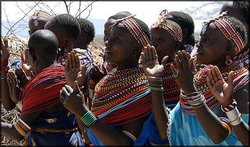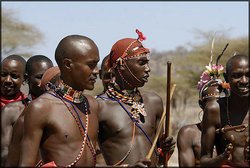Samburu
|
|
They live north of the equator in Samburu District, an area roughly 8000 square miles (21,000 km²). Its landscape is one of great diversity and beauty. Before and a few years after independence the area north of the equator was called the Northern Frontier District (NDF). Samburu district was once a large part of the NDF. Only government officials were allowed to enter and it was closed to foreigners of both European and African descent. A special permit issued by the administration was required to enter the NDF. Even today Samburuland is still a remote area.
The Samburu are part of the Maa speaking people as are the Maasai. About 95% of the words of both languages are the same. The name 'Samburu' is also of Maasai origin and is derived from the word 'Samburr' which is a leather bag used by the Samburu to carry a variety of things. It is unclear when Samburu became a distinct ethnic identity. As is common many places around the world, ethnic identities became fixed and defined at the point of colonial contact. 19th century European travellers often referred to Samburu as "Burkineji" (people of the white goats), and there are many interconnections with other neighboring ethnic groups. Some Samburu are descended from remnants of the Laikipiak Maasai, a Maasai section which was destroyed in the late 19th century. Others are from Rendille, Turkana and Borana tribes.
Samburu practice polygynous marriage, and a man may have multiple wives. A Samburu settlement is known as a nkang or manyatta. It may consist of only one family, composed of a man and his wife/wives. Each woman has her own house, which she builds out of local materials, such as sticks, mud and cow dung. Large ritual settlements, known as lorora may consist of 20 or more families. However, settlements tend towards housing two or three families, with perhaps 5-6 houses built in a rough circle with an open space in the centre. The circle of huts is surrounded by thorn bush fence.
References
- Nigel Pavitt, "Samburu", ISBN 1-85626-429-7


